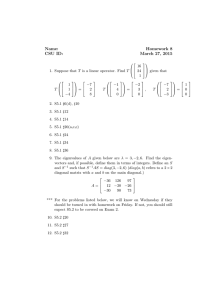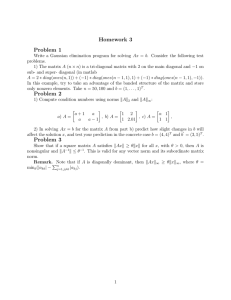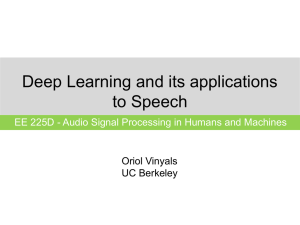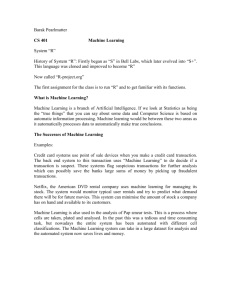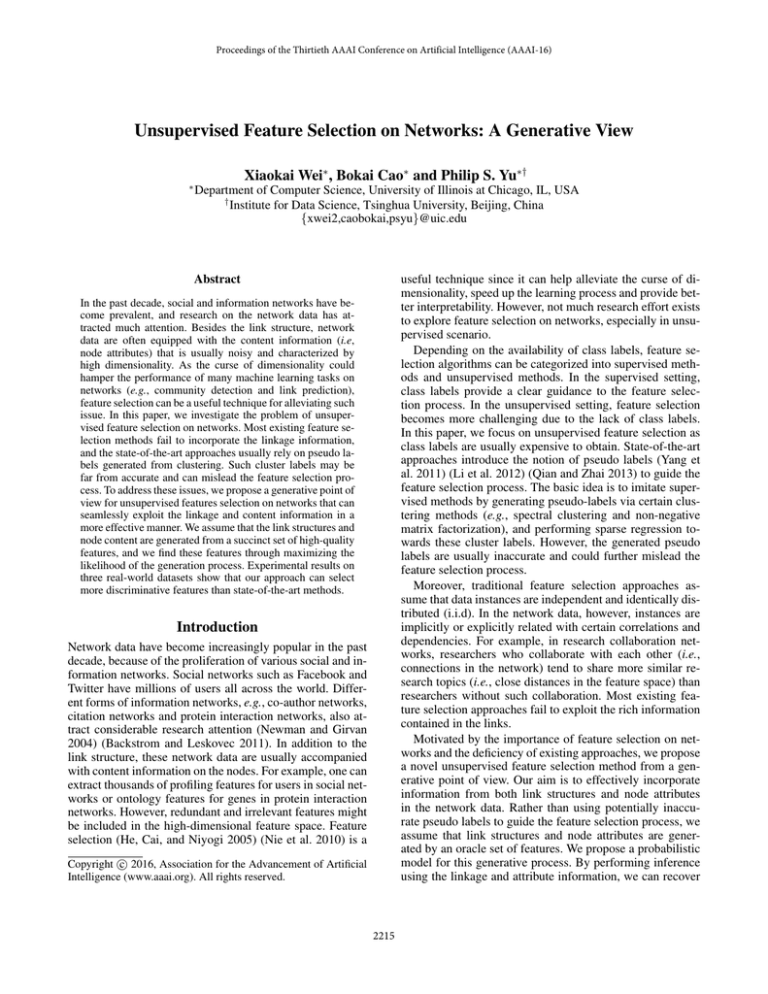
Proceedings of the Thirtieth AAAI Conference on Artificial Intelligence (AAAI-16)
Unsupervised Feature Selection on Networks: A Generative View
∗
Xiaokai Wei∗ , Bokai Cao∗ and Philip S. Yu∗†
Department of Computer Science, University of Illinois at Chicago, IL, USA
†
Institute for Data Science, Tsinghua University, Beijing, China
{xwei2,caobokai,psyu}@uic.edu
useful technique since it can help alleviate the curse of dimensionality, speed up the learning process and provide better interpretability. However, not much research effort exists
to explore feature selection on networks, especially in unsupervised scenario.
Depending on the availability of class labels, feature selection algorithms can be categorized into supervised methods and unsupervised methods. In the supervised setting,
class labels provide a clear guidance to the feature selection process. In the unsupervised setting, feature selection
becomes more challenging due to the lack of class labels.
In this paper, we focus on unsupervised feature selection as
class labels are usually expensive to obtain. State-of-the-art
approaches introduce the notion of pseudo labels (Yang et
al. 2011) (Li et al. 2012) (Qian and Zhai 2013) to guide the
feature selection process. The basic idea is to imitate supervised methods by generating pseudo-labels via certain clustering methods (e.g., spectral clustering and non-negative
matrix factorization), and performing sparse regression towards these cluster labels. However, the generated pseudo
labels are usually inaccurate and could further mislead the
feature selection process.
Moreover, traditional feature selection approaches assume that data instances are independent and identically distributed (i.i.d). In the network data, however, instances are
implicitly or explicitly related with certain correlations and
dependencies. For example, in research collaboration networks, researchers who collaborate with each other (i.e.,
connections in the network) tend to share more similar research topics (i.e., close distances in the feature space) than
researchers without such collaboration. Most existing feature selection approaches fail to exploit the rich information
contained in the links.
Motivated by the importance of feature selection on networks and the deficiency of existing approaches, we propose
a novel unsupervised feature selection method from a generative point of view. Our aim is to effectively incorporate
information from both link structures and node attributes
in the network data. Rather than using potentially inaccurate pseudo labels to guide the feature selection process, we
assume that link structures and node attributes are generated by an oracle set of features. We propose a probabilistic
model for this generative process. By performing inference
using the linkage and attribute information, we can recover
Abstract
In the past decade, social and information networks have become prevalent, and research on the network data has attracted much attention. Besides the link structure, network
data are often equipped with the content information (i.e,
node attributes) that is usually noisy and characterized by
high dimensionality. As the curse of dimensionality could
hamper the performance of many machine learning tasks on
networks (e.g., community detection and link prediction),
feature selection can be a useful technique for alleviating such
issue. In this paper, we investigate the problem of unsupervised feature selection on networks. Most existing feature selection methods fail to incorporate the linkage information,
and the state-of-the-art approaches usually rely on pseudo labels generated from clustering. Such cluster labels may be
far from accurate and can mislead the feature selection process. To address these issues, we propose a generative point of
view for unsupervised features selection on networks that can
seamlessly exploit the linkage and content information in a
more effective manner. We assume that the link structures and
node content are generated from a succinct set of high-quality
features, and we find these features through maximizing the
likelihood of the generation process. Experimental results on
three real-world datasets show that our approach can select
more discriminative features than state-of-the-art methods.
Introduction
Network data have become increasingly popular in the past
decade, because of the proliferation of various social and information networks. Social networks such as Facebook and
Twitter have millions of users all across the world. Different forms of information networks, e.g., co-author networks,
citation networks and protein interaction networks, also attract considerable research attention (Newman and Girvan
2004) (Backstrom and Leskovec 2011). In addition to the
link structure, these network data are usually accompanied
with content information on the nodes. For example, one can
extract thousands of profiling features for users in social networks or ontology features for genes in protein interaction
networks. However, redundant and irrelevant features might
be included in the high-dimensional feature space. Feature
selection (He, Cai, and Niyogi 2005) (Nie et al. 2010) is a
c 2016, Association for the Advancement of Artificial
Copyright Intelligence (www.aaai.org). All rights reserved.
2215
a succinct set of high-quality features. In this manner, we
utilize information directly from the network data without
generating intermediate pseudo labels. We refer to the proposed approach as Generative Feature Selection (GFS). To
our knowledge, no existing method has adopted a generative
view for feature selection.
As the state-of-the-art approaches on unsupervised feature selection are mostly pseudo label based methods, we
illustrate the essential differences of these approaches and
our approach in Figure 1. The class labels can be viewed
as a perfect summarization of the data and using them to
guide feature selection can usually achieve good performance (Figure 1a). Pseudo label based approaches attempt
to first summarize the information from the data via clustering, and the pseudo labels serve as a proxy between the
original data and the selected features (Figure 1b). However,
such inaccurate summarization loses much information of
the data. Our approach avoids the intermediate step and directly builds connections between the original data and the
selected features (i.e., oracle features). As a result, more information from the data could be utilized to guide the feature
selection process (Figure 1c).
data via adding network-based regularization term to enforce similarity between neighbors. In unsupervised scenario, POPFS (Wei, Xie, and Yu 2015) uses network links
to guide feature selection efficiently but it fails to use content information. Linked Unsupervised Feature Selection
(LUFS) (Tang and Liu 2012b) is the only unsupervised feature selection method that utilizes both content and link information. LUFS exploits network information through incorporating social dimension based regularization (Tang and
Liu 2009) into the UDFS framework (Yang et al. 2011). It
enforces the nodes within the same social dimension to have
similar pseudo labels. But the social dimensions generated
from links (e.g., by modularity (Newman 2006) or spectral clustering (Ng, Jordan, and Weiss 2001)) and pseudo
labels generated from attributes are usually far from accurate, which could mislead the feature selection process.
Problem Formulation
Preliminaries
In this section, we present several concepts as preliminaries of our unsupervised feature selection method. In the rest
of the paper, we use features and attributes interchangeably.
Our goal is to select a set of important features on the network with node attributes, which we refer to as attributed
network.
Related Work
Feature Selection for Traditional Data
Feature selection aims to select the most relevant ones from
a large number of features and traditional feature selection
methods generally fall into three categories: filter models
(Zhao and Liu 2007) (Peng, Long, and Ding 2005), wrapper models (Dy and Brodley 2004) and embedded models
(Cawley, Talbot, and Girolami 2006) (Tibshirani 1996).
Our work focuses on unsupervised scenario as class labels
are usually expensive to obtain. One popular guiding principle for unsupervised feature selection is to preserve the local
manifold structure or similarity (He, Cai, and Niyogi 2005)
(Zhao and Liu 2007) (Zhao, Wang, and Liu 2010). Recently,
pseudo label based frameworks (Yang et al. 2011) (Li et
al. 2012) (Qian and Zhai 2013) have gained much popularity. Unsupervised Discriminative Feature Selection (UDFS)
(Yang et al. 2011) introduces pseudo labels to better capture the discriminative information and the sparsity-inducing
L2,1 norm is used to select features in an iterative manner.
NDFS (Li et al. 2012) performs non-negative spectral analysis and feature selection simultaneously. RUFS (Qian and
Zhai 2013) and RSFS (Shi, Du, and Shen 2014) utilizes robust learning framework for generating pseudo labels. Essentially, different pseudo label based methods all use a
L2,1 -regularized regression based framework with different clustering algorithms and constraints on pseudo labels.
Since the clustering label is usually far from the groundtruth, it could result in degenerated quality of selected features.
Definition 1 (Attributed Network) An attributed network
G = (V, E, X) consists of V , the set of nodes, E ⊆ V × V ,
the set of links, and X = [x1 , x2 , . . . , xn ] where n = |V |
and xi ∈ RD is the feature/attribute vector of the node vi .
In the supervised setting, one can select discriminative
features that provide good separability of different classes.
For unsupervised feature selection, there is no such clear
guidance due to the lack of labels. Instead of relying on inaccurate pseudo labels, we aim to directly exploit the information from the data. From a generative point of view, we
assume that link structures and node features are generated
by an oracle set of features. Our goal is to recover this set
of features through inference on the network. Specifically,
we assume that there are d D important features among
all features which are referred to as oracle features. All the
node content and the network links are generated by these d
oracle features. We use s = {0, 1}D as the indicator vector
for oracle features, where sp equals 1 if the p-th feature is an
oracle feature and 0 otherwise. Let us denote the diagonal
matrix with diagonal elements s as diag(s). Therefore, the
oracle feature vector of the node vi is diag(s)xi .
Modeling Link Generation
Most unsupervised feature selection methods cannot exploit
linkage information. In our generative framework, we can
incorporate linkage information seamlessly. From a generative point of view, we assume that the links are generated
from a set of oracle features. More specifically, we assume
that the probability of a link is determined by the oracle
affinity between two nodes defined as follows.
Feature Selection for Network Data
In recent years, efforts have been made towards feature selection on network data. (Gu and Han 2011) (Tang and
Liu 2012a) address supervised feature selection on network
2216
(a) Supervised feature selection
(b) Pseudo-label approach
(c) Generative Feature Selection
Figure 1: Illustration of different feature selection approaches
using Fg (aij ) =
Definition 2 (Oracle Affinity) Oracle affinity is determined by the dot product of oracle features of two nodes.
aij = xTi diag(s)xj
1
1+e−aij −b
is the following:
LG = − log(P (G|s))
1
log
=−
1 + exp (−xTi diag(s)xj − b)
(1)
(i,j)∈E
We assume that the oracle affinity is determined by oracle features rather than all the original features to avoid
redundancy and irrelevance in the high-dimensional input
space. Consider a collection of computer science papers on
different topics (e.g., machine learning, operating system,
database) and citation links between them. Indiscriminative
terms, such as propose, related and conclusion, contain little
information in determining the essential similarity between
two papers. Since two linked papers are more likely to share
similar topics than two random papers, informative terms
such as LDA, classification and database would be useful in
generating the links. Thus, if a feature is highly indicative
of the existence of links, it is likely to be an informative and
discriminative feature. By recovering the oracle features via
exploiting network links, we are able to select a set of discriminative features. To achieve this, we introduce the following generative process:
−
log
(i,j)∈E
/
=
exp (−xTi diag(s)xj − b)
1 + exp (−xTi diag(s)xj − b)
(4)
log(1 + exp (−xTi diag(s)xj − b))
(i,j)∈V ×V
+
(xTi diag(s)xj + b)
(i,j)∈E
/
In real-world applications, network data can be very sparse,
i.e., linked node pairs are far less than non-linked node pairs.
Due to such imbalanced distribution, LG would be dominated by the loss on non-linked node pairs. To address this
issue, we under-sample the non-linked node pairs to make
their size comparable to the linked node pairs. With downsampling, LG is reformulated as follows:
1
log
LG = −
1 + exp (−xTi diag(s)xj − b)
(i,j)∈E
pij =Fg (aij )
Eij ∼Bernoulli(pij )
−
(2)
(i,j)∈E
pij ·
(i,j)∈E
/
(1 − pij )
=
exp (−xTi diag(s)xj − b)
1 + exp (−xTi diag(s)xj − b)
(5)
log(1 + exp (−xTi diag(s)xj − b))
(i,j)∈E∪SN
+
(xTi diag(s)xj + b)
(i,j)∈SN
where SN denotes the set of sampled non-linked node pairs.
It is worth noting that our link generation approach differs
from graph regularization (Gu and Han 2011) (Tang and Liu
2012a) in two important aspects: first, graph regularization
usually enforces similarity on linked pairs but fails to utilize
information from unlinked pairs; second, graph regularization is usually used on cluster membership/latent factors (as
in existing pseudo-label methods) rather than directly on the
oracle features. And actually, applying graph regularization
on diag(s)xi directly will favor those features that appear
indiscriminatively since it fails to penalize features that are
frequently shared by unlinked pairs.
Eq (2) describes the generative process from oracle features to the links in networks. By assuming links are i.i.d,
the probability of the whole network given the oracle features is as follows:
log
(i,j)∈SN
where Fg (·) is a function that transforms the oracle affinity aij to the linkage probability pij . Fg (·) should be nondecreasing so that a larger affinity would lead to a larger
probability of connection. For example, it could be the sigmoid function, i.e., Fg (aij ) = 1/(1 + e−aij ). We further introduce a bias term b ∈ R, so Fg (aij ) = 1/(1 + e−(aij +b) ).
P (G|s) =
(3)
The negative log-likelihood for generating the network links
2217
Modeling Content Generation
on both link and content. By assuming the conditional independence of G and C given b, s and W, the total negative
log-likelihood is as follows:
In addition to the linkage information, it is critical to incorporate information from the node content. We assume that
each node generates its attributes from the set of oracle features with a mapping function. That is to say, the oracle features can be regarded as a succinct summary of all the features. This intuition can be formalized as follows:
μi =Fc (diag(s)xi )
2
xi ∼N (μi , σ ID )
min
s,b,W
s.t. sp ∈ {0, 1}, ∀p = 1, . . . , D
D
(6)
Optimization
(7)
min L = LG + LC + λ||s||1
s,b,W
s.t. 0 ≤ sp ≤ 1, ∀p = 1, . . . , D
(8)
(9)
Note that other distributions could also be used for modeling
feature generation. For example, one can consider Bernoulli
distribution if the features are binary.
1
1 + exp(−Fc (diag(s)xi ))
xi ∼Bernoulli(μi )
μi =
(12)
where the sparsity-inducing L1 norm ||s||1 is equal to
D
p=1 sp , because we enforce s to be non-negative (i.e.,
0 ≤ sp ≤ 1). The value of sp can be interpreted as the pth feature’s importance score in generating the content and
linkage information. Important features would have scores
close to 1 and scores of less useful features tend to shrink
towards 0. After obtaining the relaxed solution on s, we can
rank all the features by their importance scores and select
the top d features as the oracle features.
For the optimization problem in Eq (12), we need to optimize jointly on the selection vector s, bias term b and the
projection matrix W. Since Eq (12) is not jointly convex on
s, b and W, we adopt an alternating optimization framework
to obtain a local optima.
Step 1. Fix W and optimize Eq (12) over s and b.
With fixed W, Eq (12) is a convex optimization problem
on s and b. For real-valued s, both LG and LC is differentiable. For the loss incurred on link structures, the gradient
of LG with respect to s can be calculated as follows:
where || · ||F denotes the Frobenius norm of a matrix. By
finding the oracle features that minimize Eq (8), we select
the most important features that preserve the information of
node attributes in the network data. We also need to impose a
norm on W to control its complexity and avoid overfitting.
We choose Frobenius norm for the simplicity of optimization.
LC = ||XT diag(s)W − XT ||2F + β||W||2F
sp = d
In this section, we develop a method for performing inference with features and links. The optimization problem in
Eq (11) is a ‘0/1’ integer programming problem. To make
the optimization tractable, we relax the 0/1 constraint on s
and only require s to be a real-valued vector in the range
of [0, 1]. Moreover, we can write the summation constraint
D
p=1 sp = d in the form of Lagrangian:
where W ∈ RD×D is a projection matrix that represents
all the features using oracle features. Only d rows of W are
non-zero which correspond to the non-zero elements of s. If
all the original features could be approximated by the oracle
features through Fc (·), the oracle features arguably contain
the essential information of the node content.
It is easy to verify that, given fixed W, maximizing the
log-likelihood of content generation under Eq (6) is equivalent to minimizing the sum of square error:
||XT diag(s)W − XT ||2F
(11)
p=1
where N is the Gaussian distribution and Fc (·) is the function that generates xi from the oracle features diag(s)xi .
There could be different choices for the generation function
Fc (·). For simplicity, we use a linear mapping as the generating function.
Fc (diag(s)xi ) = WT diag(s)xi
− log P (G, C|s, b, W) = LG + LC
(10)
∂LG
=−
∂sp
where μi determines the probability of occurrence of xi . It
is easy to see that both Eq (6) and Eq (10) are special cases of
Generalized Linear Model (GLM) with different link functions. Eq (6) corresponds to linear regression and Eq (10)
corresponds to logistic regression.
+
xTip xjp
(i,j)∈E∪SN
exp (−xTi diag(s)xj − b)
1 + exp (−xTi diag(s)xj − b)
xTip xjp
(i,j)∈SN
(13)
The gradient of LC with respect to s is the following:
Combining Things Together
∂LC
= [X(XT diag(s)W − XT )WT ]pp
∂sp
We have discussed how to generate attributes and links from
oracle features in previous sections. Now we put things together and aim to select a set of high-quality features that
are optimal considering both content and link generation.
Therefore, we aim to minimize the negative log-likelihood
(14)
where [·]pp denotes the p-th diagonal element of matrix [·].
The L1 norm in general is non-smooth at zero. However,
since in our case s is guaranteed to be non-negative, the L1
2218
regularization on non-negative s is differentiable with gradient 1. So the gradient of the whole objective function is
∂L
∂LG
∂LC
=
+
+λ
∂sp
∂sp
∂sp
Table 1: Statistics of three datasets
Statistics
# of instances
# of links
# of features
# of classes
(15)
Since we also require s to be in the range [0, 1], we perform Projected Gradient Descent (PGD) (Calamai and Moré
1987) for this constrained optimization problem. We project
s back to [0, 1] after each gradient updating step.
(i,j)∈E∪SN
Wiki
3363
33219
4973
19
We use three publicly available network datasets with node
attributes: Citeseer dataset, Cora Dataset and Wikipedia
dataset 1 (Sen et al. 2008). One can refer to the link in the
footnote for more details on the datasets. The statistics of
three datasets are summarized in Table 1.
We compared our approach to the following baseline
methods: (a) All Features; (b) Link Only (Spectral clustering
using network links); (c) LS (Laplacian Score) (He, Cai, and
Niyogi 2005); (d) UDFS (content only) (Yang et al. 2011)
(e) LUFS (which incorporates both content and link information) (Tang and Liu 2012b); (f) RSFS (content only) (Shi,
Du, and Shen 2014).
Following the typical setting (Yang et al. 2011) (Tang
and Liu 2012b) of evaluation for unsupervised feature selection, we use Accuracy and Normalized Mutual Information (NMI) to evaluate the result of clustering. Accuracy is
measured as follows.
n
1
I(ci = map(pi ))
(19)
Accuracy =
n i=1
Moreover, the gradient with respect to the bias term b is
Cora
2708
5429
1433
7
Experiment Setup
Proj[0,1] (sp ) = min(max(0, sp ), 1), ∀p = 1, . . . , D (16)
∂LG
=−
∂b
Citeseer
3312
4598
3703
6
exp(−xTi diag(s)xj − b)
+ |SN |
1 + exp(−xTi diag(s)xj − b)
(17)
where |SN | denotes the total number of sampled non-linked
node pairs.
Step 2. Fix s and b, optimize Eq (12) over W.
With fixed s, the optimization with respect to W is convex and we can obtain the closed form solution for W as
follows:
W = (diag(s)XXT diag(s) + βID )−1 diag(s)XXT (18)
where ID is an D×D identity matrix. Algorithm 1 shows the
optimization method based on projected gradient descent.
We alternatively perform step 1 and step 2 in an iterative
manner until it converges or reaches user-specified maximum number of iterations.
The objective function in Eq (12) monotonically decreases in each iteration and it has a lower bound. Hence,
Algorithm 1 can converge to a local minima of the objective
(proof can be derived in similar manner as in (Grippo and
Sciandrone 2000)).
where pi is the clustering result of data point i and ci is its
ground truth label. map(·) is a permutation mapping function that maps pi to a class label using Kuhn-Munkres Algorithm.
NMI is calculated as follows. Let C be the set of clusters
from the ground truth and C is obtained from a clustering
algorithm.
N M I(C, C ) =
Algorithm 1 Alternating Optimization with Projected Gradient Descent
Initialize: s0 = 0D , b0 = 0, W0 = 0D×D , t = 0.
repeat
t=t+1
Update st and bt through performing projected gradient descent by Eq (15) and Eq (17) with W(t−1)
Find the optimal Wt by Eq (18) with st .
until converged or t = maxIterations
Sort features w.r.t. st and output the top d features.
M I(C, C )
max(H(C), H(C ))
(20)
where H(C) and H(C ) are the entropy of C and C and
M I(C, C ) is the mutual information. Higher value of NMI
indicates better quality of clustering.
Since it is difficult to determine the optimal values of parameters in unsupervised setting, we use the parameter setting for the baseline methods as suggested in the sensitivity analysis section of the original papers. For the number
of pseudo classes in UDFS, LUFS and RSFS, we use the
ground-truth number of classes. For the proposed method
GFS, we found it is not sensitive to the parameters in a
reasonable range. So we fix the parameters of GFS for all
datasets with β = 1 and λ = 1.
As in previous work (Yang et al. 2011) (Tang and Liu
2012b), we use K-means2 for evaluation. Since K-means is
Experiment
In this section, we evaluate the feature quality by performing clustering (community detection) on the features. Experimental results show that GFS significantly outperforms the
state-of-the-art methods in terms of feature quality.
1
http://linqs.cs.umd.edu/projects//projects/lbc/index.html
We use the code at http://www.cad.zju.edu.cn/home/dengcai/
Data/Clustering.html
2
2219
0.7
0.45
0.5
0.45
0.6
0.4
0.4
0.4
0.3
LS
UDFS
LUFS
RSFS
GFS
Link Only
All Features
0.2
0.1
0
200
0.35
0.3
LS
UDFS
LUFS
RSFS
GFS
Link Only
All Features
0.25
0.2
400
600
Number of selected features
(a) Accuracy on Citeseer
0.35
0.3
0.25
0.1
200
400
600
Number of selected features
0.35
0.5
0.3
0.3
0.45
0.25
0.25
LS
UDFS
LUFS
RSFS
GFS
Link Only
All Features
0.1
0.05
0
200
400
600
Number of selected features
(d) NMI on Citeseer
0.4
0.35
0.2
NMI
0.2
0.15
0.3
0.25
LS
UDFS
LUFS
RSFS
GFS
Link Only
All Features
0.1
0.05
0
200
400
600
Number of selected features
(c) Accuracy on Wiki
0.35
0.15
LS
UDFS
LUFS
RSFS
GFS
Link Only
All Features
0.2
0.15
(b) Accuracy on Cora
NMI
NMI
Accuracy
Accuracy
Accuracy
0.5
200
400
600
Number of selected features
(e) NMI on Cora
LS
UDFS
LUFS
RSFS
GFS
Link Only
All Features
0.2
0.15
0.1
200
400
600
Number of selected features
(f) NMI on Wiki
Figure 2: Clustering results on three datasets
affected by the initial seeds, we repeat the experiment for
20 times and report the average performance. We vary the
number of features in the range {200, 400, 600}. The Kmeans clustering performance for three datasets is shown in
Figure 2.
datasets, respectively. Baseline LUFS also attempts to exploit link information via extracting social dimensions (Tang
and Liu 2009) from links. But social dimensions extracted
from noisy and sparse links can be unreliable and this may
further mislead the feature selection process. For example,
in Citeseer dataset, the network is sparse and each node only
has 1.39 links on average. So the derived social dimensions
make LUFS even worse than UDFS and RSFS which do
not utilize linkage information. In contrast, GFS can benefit
from exploiting the links even when the network structure is
sparse, as shown in the case of Citeseer dataset.
Results
We can observe from Figure 2 that feature selection is an
effective way to enhance the clustering/community detection performance. With much less features, GFS can obtain
significantly better accuracy and NMI than using all the features. For instance, compared with using all features, GFS
with 200 features improves the accuracy of clustering by
21.0%, 6.0% and 10.4% on Citeseer, Cora and Wikipedia,
respectively. This illustrates the importance of feature selection on networks, since the original feature space can have
many low quality/noisy features. It is also worth noting that
clustering using only links does not perform very well. This
is because network links are often sparse and noisy, and
structural information alone is not sufficient to obtain good
clusters. But using link structures as guidance in addition to
the node content to select features can achieve much better
performance, which illustrates the strength of our proposed
GFS framework.
When comparing GFS with other unsupervised feature selection approaches, we observe that GFS performs consistently better than baseline methods on different datasets with
different numbers of selected features. This indicates that
the proposed generative view is an effective framework for
selecting high-quality features on network data. LS, UDFS
and RSFS are unable to exploit network structure and do
not perform as well as GFS. Compared with the most competitive feature selection baseline RSFS, GFS outperforms
RSFS by 44.5%, 9.2% and 35.2% with 200 features on three
In summary, noisy features can be detrimental to the performance of clustering/community detection and appropriately designed unsupervised feature selection method, such
as GFS, can alleviate this issue.
Conclusion
In the era of big data, many data instances are connected
through link structures in the form of social/information networks. While network links contain valuable information,
most state-of-the-art unsupervised feature selection methods
either do not utilize the linkage information or utilize the
linkage information in a less effective way. In this paper, we
develop an unsupervised feature selection algorithm from a
generative point of view which can incorporate information
from the node content and links directly. We assume that the
node attributes and link structures are generated from a set of
oracle features and we aim to recover this set of high-quality
features based on the generation process. Experiments indicate that our approach significantly outperforms state-ofthe-art methods in terms of feature quality.
2220
Acknowledgements
Tang, J., and Liu, H. 2012b. Unsupervised feature selection
for linked social media data. In KDD, 904–912.
Tibshirani, R. 1996. Regression shrinkage and selection via
the lasso. Journal of the Royal Statistical Society (Series B)
58:267–288.
Wei, X.; Xie, S.; and Yu, P. S. 2015. Efficient partial order
preserving unsupervised feature selection on networks. In
SDM.
Yang, Y.; Shen, H. T.; Ma, Z.; Huang, Z.; and Zhou, X. 2011.
l2, 1-norm regularized discriminative feature selection for
unsupervised learning. In IJCAI, 1589–1594.
Zhao, Z., and Liu, H. 2007. Spectral feature selection for supervised and unsupervised learning. In ICML, volume 227,
1151–1157.
Zhao, Z.; Wang, L.; and Liu, H. 2010. Efficient spectral
feature selection with minimum redundancy. In AAAI.
This work is supported in part by NSF through grants III1526499, CNS-1115234, and OISE-1129076, and Google
Research Award.
References
Backstrom, L., and Leskovec, J. 2011. Supervised random walks: predicting and recommending links in social
networks. In WSDM, 635–644.
Calamai, P., and Moré, J. 1987. Projected gradient methods
for linearly constrained problems. Mathematical Programming 39:93–116.
Cawley, G. C.; Talbot, N. L. C.; and Girolami, M. 2006.
Sparse multinomial logistic regression via bayesian l1 regularisation. In NIPS, 209–216.
Dy, J. G., and Brodley, C. E. 2004. Feature selection for unsupervised learning. Journal of Machine Learning Research
5:845–889.
Grippo, L., and Sciandrone, M. 2000. On the convergence
of the block nonlinear Gauss-Seidel method under convex
constraints. Operations Research Letters 26:127–136.
Gu, Q., and Han, J. 2011. Towards feature selection in network. In CIKM, 1175–1184.
He, X.; Cai, D.; and Niyogi, P. 2005. Laplacian score for
feature selection. In NIPS.
Li, Z.; Yang, Y.; Liu, J.; Zhou, X.; and Lu, H. 2012. Unsupervised feature selection using nonnegative spectral analysis. In AAAI.
Newman, M. E. J., and Girvan, M. 2004. Finding and
evaluating community structure in networks. Phys. Rev. E
69(2):026113.
Newman, M. E. 2006. Modularity and community structure
in networks. Proc Natl Acad Sci U S A 103(23):8577–8582.
Ng, A. Y.; Jordan, M. I.; and Weiss, Y. 2001. On spectral
clustering: Analysis and an algorithm. In NIPS, 849–856.
MIT Press.
Nie, F.; Huang, H.; Cai, X.; and Ding, C. H. Q. 2010. Efficient and robust feature selection via joint l2, 1-norms minimization. In NIPS, 1813–1821.
Peng, H.; Long, F.; and Ding, C. H. Q. 2005. Feature
selection based on mutual information: Criteria of maxdependency, max-relevance, and min-redundancy. IEEE
Trans. Pattern Anal. Mach. Intell. 27(8):1226–1238.
Qian, M., and Zhai, C. 2013. Robust unsupervised feature
selection. In IJCAI.
Sen, P.; Namata, G. M.; Bilgic, M.; Getoor, L.; Gallagher,
B.; and Eliassi-Rad, T. 2008. Collective classification in
network data. AI Magazine 29(3):93–106.
Shi, L.; Du, L.; and Shen, Y. 2014. Robust spectral learning
for unsupervised feature selection. In ICDM, 977–982.
Tang, L., and Liu, H. 2009. Relational learning via latent
social dimensions. In KDD.
Tang, J., and Liu, H. 2012a. Feature selection with linked
data in social media. In SDM, 118–128.
2221

